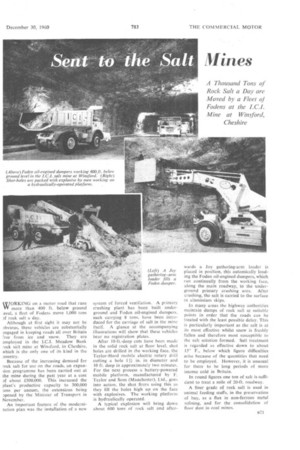Alines
Page 55

If you've noticed an error in this article please click here to report it so we can fix it.
A Thousand Tons of Rock Salt a Day are Moved by a Fleet of Fodens at the I.C.I. Mine at Winsfbrd,
Cheshire
WORKING on a motor road that runs W more than 400 ft. below ground .eve!, a fleet of Fodens move 1,000 tons A rock salt a day.
Although at first sight it may not be 3bvious, these vehicles are substantially mgaged in keeping roads all over Britain Free from ice and snow. They are employed in the I.C.I. Meadow Bank rock salt mine at Winsford, in Cheshire, which is the only one of its kind in the -;ountry.
Because of the increasing demand for rock salt for use on the roads, an expan;ion programme has been carried out at the mine during the past year at a cost A about £500,000. This increased the plant's productive capacity to 300,000 tons per annum, the extensions being Jpened by the Minister of Transport in November.
An important feature of the rnoderniEation plan was the installation of a new system of forced ventilation. A primary crushing plant has been built underground and Foden oil-engined dumpers, each carrying 8 tons, have been introduced for the carriage of salt in the mine itself, A glance at the accompanying illustrations will show that these vehicles bear no registration plates.
After 10-ft-deep cuts have been made in the solid rock salt at floor level, shot holes are drilled in the working face, the Taylor-Hurd mobile electric rotary drill cutting a hole 11,11; in. in diameter and 10 ft. deep in approximately two minutes. For the next process a battery-powered mobile platform, manufactured by F. Taylor and Sons (Manchester), Ltd., goes into action, the shot firers using this as they fill the holes high up on the face with explosives. The working platform is hydraulically operated.
A typical explosion will bring down about 600 tons of rock salt and after wards a Joy gathering-arm loader is placed in position, this automicalfy loading the Foden oil-engined dumpers, which run continually from the working face, along the main roadway, to the underground primary crushing area. After crushing, the salt is carried to the surface in aluminium skips.
In many areas the highway authorities maintain dumps of rock salt at suitable points in order that the roads can be treated with the least possible delay. This is particularly important as the salt is at its most effective whilst snow is freshly fallen and therefore most susceptible to the salt solution formed. Salt treatment is regarded as effective down to about 15 F., below which figure difficulties arise because of the quantities that need to be employed. However, it is unusual for there to be long periods of more intense cold in Britain.
In round figures one ton of salt is sufficient to treat a mile of 20-ft. roadway.
A finer grade of rock salt is used in animal feeding stuffs, in the preservation of hay, as a flux in non-ferrous metal refining, and for the consolidation of floor dust in coal mines.




























































































